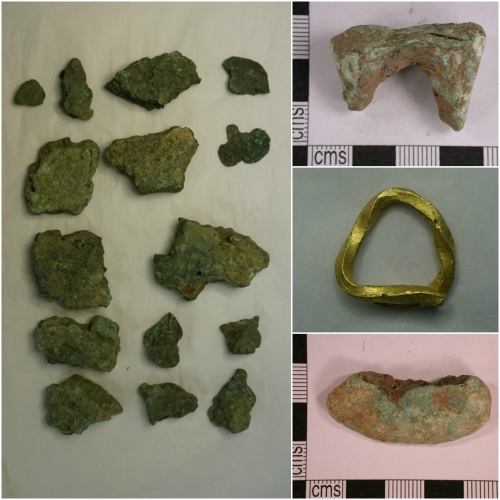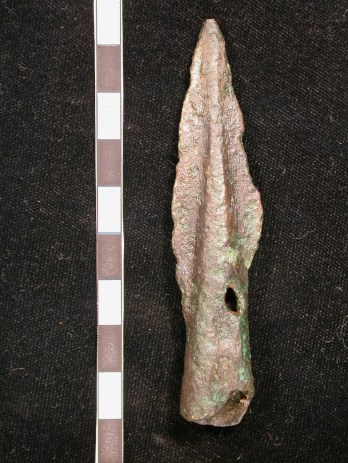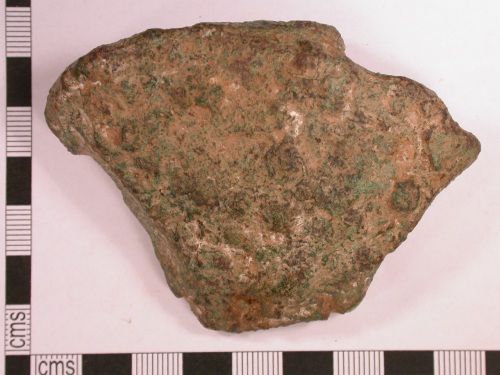Cornwall. It’s a weird and wonderful place, and not quite like anywhere else I’ve ever been, ranging from harsh, barren moorlands to stunning coastal scenes. Sitting at the tip of the South West peninsula, it’s the first of the counties in my blog series on the PAS material from my study region.

St. Michael’s Mount – the site of a major Late Bronze Age hoard
I’ve already touched on some of the Cornish material in a previous blog post. The PAS has been a fundamental source for recording Bronze Age hoards from the county in recent years. But numerous single finds have also come up. Overall, the Cornish PAS metalwork has contributed about 50 findspots to my database, with about 200-250 objects.

Various finds from across Cornwall. Photos courtesy of the Royal Cornwall Museum and Portable Antiquities Scheme
Almost all the material is incomplete in some way. Some is accidental. Some is deliberate.
Here I’m going to put up a few of my favourites and some of the most interesting finds, though there are of course a lot more!
St. Keverne stone axe mould (CORN-031000)
First on the list is actually a non-metal find from St. Keverne. This is the lower piece of one half of a bivalve mould for casting socketed axes. It’s been beautifully made and has a potential loop on a curved face. Shaping this mould would have taken several days.
Callington (CORN-740B97)
Very few spearheads are known from Cornwall (by my reckoning, about 16) and this is the only one recorded through the PAS system. It dates to the Late Bronze Age and has suffered badly from corrosion, though some of the damage to the blade wings may have been inflicted during use.

Photo courtesy of the Portable Antiquities Scheme
Gwinear-Gwithian (CORN-BD3DD5)
Ingots. They are the bane of my life. About 150 are known from Cornwall alone and almost all of them are incomplete. This is a particularly large piece from the Gwinear-Gwithian parish, representing about a quarter of a Late Bronze Age plano-convex ingot (flat on one side, domed on the other). They’re particularly interesting for my thesis are one must assume this is deliberate destruction with a function (i.e. for use in a crucible).

Photo courtesy of the Portable Antiquities Scheme
Socketed Axe fragments
I mentioned in my introductory post that the PAS is particularly good at bringing odd unrecognisable fragments into the research picture. No object emphasises this better than the bits of socketed axes that have been recovered across not just Cornwall, but the whole of the peninsula. Expect to see several more of these kinds of pictures, as my experiments hitting metal objects have shown that the best way to create these fragments is through deliberate destruction. Below we have socketed axe fragments from Sennen (CORN-214B63), Ludgvan (CORN-F29E04), St. Columb Major (CORN-6CB647) , and Padstow (CORN-431AF8) (Top left to bottom right).

Photos courtesy of the Portable Antiquities Scheme
The St. Erth Deposits
Finally, I know I’ve mentioned them before, but you can never have too much of a good thing. Two hoards and two pieces of goldwork were recovered from a hilltop in the parish of St. Erth all dating to the Ewart Park phase of the Late Bronze Age (c.900-800 BC). These deposits contribute to the numerous Late Bronze Age hoards that have been found recently and recorded through the PAS. The St. Erth material totals 43 complete and incomplete objects, showing various signs of destruction, including sword fragments, a hog-back knife, a winged axe fragment, and lots of ingot fragments. The hilltop positioning might be particularly significant, especially when one thinks about the positioning of other hoards in the region (e.g. St. Michael’s Mount).

Some of the material from one of the St. Erth hoards (photo taken courtesy of the Royal Cornwall Museum)
If you enjoyed this post, why not check out my others on the PAS material from Devon, Somerset and Dorset!
Acknowledgements
Much of my research into Cornwall has been facilitated and enhanced by numerous visits to the Royal Cornwall Museum and in particular assistance from Anna Tyacke, the FLO for Cornwall.







[…] been studying from the Portable Antiquities Scheme database. Be sure to check out my other post on Cornwall! My thanks must go to Danielle Wootton (the FLO for Devon) for her help, as well as Thomas Cadbury […]
LikeLike
[…] from the Portable Antiquities Scheme database. Be sure to check out my other posts on Devon and Cornwall! My thanks must go to Dorset County Museum who have allowed me access to see some of this […]
LikeLike
[…] posts on Cornwall, Devon and Dorset are now available for your viewing pleasure with Somerset following in the […]
LikeLike
[…] And so I reach the final of my four counties: Somerset. Again, it is a diverse environment, some parts flooding heavily, contrasted by upland areas which served as centres for barrow cemeteries and monuments, as well as embanked settlements that acted as precursors for hillforts. Inevitably the character of metalwork recovered through the PAS differs from the previous counties presented: there’s less gold than Dorset, fewer ingots than Devon, more spearheads than Cornwall. […]
LikeLike